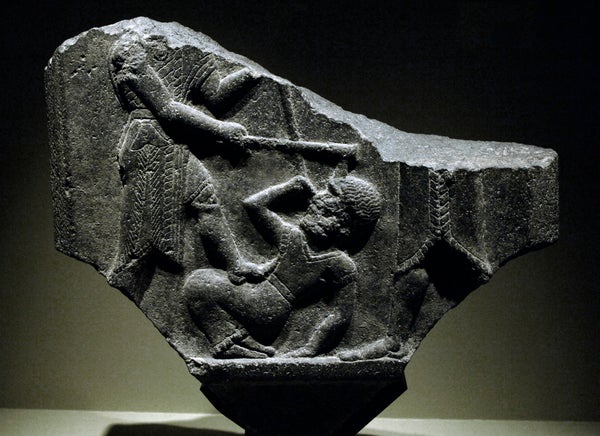Anthropologists have long debated whether human societies have become more or less violent since the first states rose to power thousands of years ago. Until recently, viewpoints on the matter divided roughly into two camps: the “doves,” who viewed preclassical civilizations as largely harmonious until the dawn of agriculture, and the “hawks,” who perceived early settlements as brutal, warlike places that became more peaceful after people began farming cooperatively.
The merits of the arguments on one side or the other have always been suspect because of a lack of solid evidence for either case. A new study takes a crack at answering the question, but its conclusions imply that neat dove-versus-hawk categorizations are overly simplistic. The amount of violence present in any society might not conform to a linear trajectory that moves continuously in an upward or descending direction.
Instead periods of violence appear to have flared up before later simmering down numerous times in different regions depending on myriad factors, according to the study, which was published in Nature Human Behaviour. The authors looked at a period of Middle Eastern history between 12,000 and 400 B.C.E. and drew from the skeletal remains of more than 3,500 individuals. The scientist found that evidence of interpersonal violence—primarily in the form of head trauma—increased significantly during times of socioeconomic upheaval and shifting climate.
On supporting science journalism
If you're enjoying this article, consider supporting our award-winning journalism by subscribing. By purchasing a subscription you are helping to ensure the future of impactful stories about the discoveries and ideas shaping our world today.
“It’s great to see such a big dataset from a region where we haven’t had these large-scale studies,” says Linda Fibiger, a bioarchaeologist at the University of Edinburgh, who was not directly involved in the study but helped review the paper.
Interpersonal violence—defined as murder, assault, slavery, torture and other forms of physical abuse—has plagued humanity for millennia. But historically, it has been difficult for researchers to measure exactly how prominent violence was in ancient civilizations—especially in prehistoric societies, where written records of conflict are nonexistent. Instead of relying on historical documents, the authors of the new study looked directly at skeletons unearthed in present-day Turkey, Iran, Iraq, Syria, Lebanon, Israel and Jordan.
“Archaeology is actually a very powerful means to distinguish this kind of stuff,” says Giacomo Benati, an interdisciplinary economic historian at the University of Barcelona and co-author of the study. Specifically, he and his team looked for remains whose skulls featured evidence of blunt-force trauma during the person’s lifetime.
Benati says that the team focused on skulls that had been damaged above the “hat-brim line,” an imaginary tracing across the forehead that anthropologists often use to differentiate an intentional blow from an accident. “There’s good reason for that,” Fibiger says. Injuries sustained in a fall tend to occur around the eyes, nose and brow, whereas the top of the head “has always been a target for violent confrontations.”
The researchers also examined other parts of the skeletons for signs of weapon-related injuries, such as puncture marks or arm fractures from self-defense. The team relied less on these trauma patterns, however, because they can be harder to distinguish from accidental wounds. The results showed that violence in the ancient Middle East peaked during a period known as the Chalcolithic, between 6,500 and 5,300 years ago. It then settled down during the early and middle Bronze Age as states consolidated their ability to control aggressive acts, only to spike again at the beginning of the Iron Age, just more than 3,000 years ago.
The Chalcolithic represented a transitional time in the region’s history. Early scattered settlements were growing and beginning to form into centralized states, and metal weapons were rapidly replacing wooden and stone implements. Fueled by larger populations, higher stakes and better weapons, violence began to trend upward.
Similarly, the Iron Age saw an upgrade in weapons quality, from bronze to more durable iron, and a political realignment as the Assyrian empire rose to power. But in addition to these political and technological upheavals, the region also buckled under the weight of a major “climate shock”: a 300-year-long drought that displaced thousands of people and triggered widespread famine.
These findings have the makings of being a stark warning for our current climate-challenged planet. As Earth’s temperature continues to rise, many experts worry that violent conflict will rise along with it. But, Benati cautions, the modern day and the historical record lack a one-to-one correspondence. “There is substantial evidence that extreme climate events could impact levels of conflict,” he says. “But it is also true that from our study, we see that when there are institutions that are capable of reducing and capping violence, the conflict could be reduced.”
Still, in the coming decades, it may become increasingly critical to look forward by glancing back at the history of violence and the factors that fuel it. “Certainly, now we are in a much better position to understand both,” Benati says.
